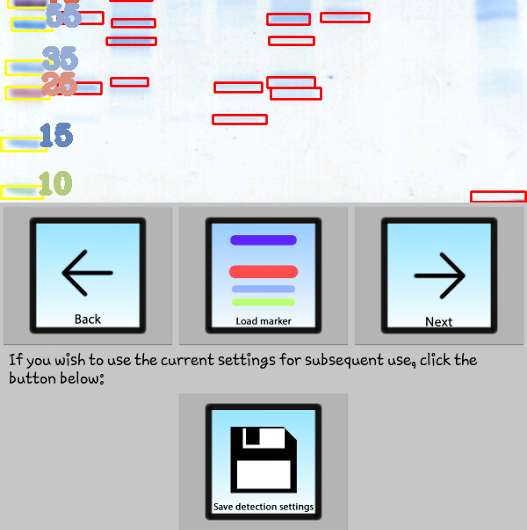Mobile software simplifies measurements of gel electrophoresis

The first Android mobile application that can automatically detect gel electrophoresis bands and accurately measure their size has been developed by A*STAR researchers.
"GelApp provides a highly accurate readout of band size—calculated to the decimal point—and includes a memory function for storing and reproducing standard markers," says Samuel Gan, who led the research team at the A*STAR Bioinformatics Institute (BII). "It beats eye-balling."
Gel electrophoresis is a standard technique used by molecular biologists to segregate proteins, DNA fragments or RNA strands based on their size and charge.
The method involves injecting unknown samples at one end of a gel under an electric field. Molecules of different sizes travel at different speeds through pores in the gel and appear as distinct bands when stained. These bands can be measured using a simple ruler. Used for decades, the technique can spot truncated genes, confirm the presence of clones or identify changes in proteins.
Accurate band measurement can be achieved using image processing software, but many of these are often poor detectors of faint bands. Equipment specifically designed to capture and quantify gel samples can solve this problem but is significantly more costly.
"Now, instead of having ten researchers queuing for one bulky machine, you can have ten smartphones installed with GelApp," says Gan. "This will increase the productivity and efficiency of biomedical research."
GelApp has a simple user interface. Researchers first choose between two options—DNA analysis or protein analysis—and upload their images from local or cloud-based storage drives. The images can be cropped or edited for brightness, darkness and clarity to improve band visibility. GelApp then calculates and compares the band sizes against previously defined or manually entered standard marker values (see image).
To improve the efficiency of isolated band detection, Gan's team worked with BII's Lee Hwee Kuan to incorporate an image processing tool called a Gabor filter in this step.
Almost 800 users have downloaded the Android and iOS versions of the app since it was launched in early 2015, together with detailed user guides and video tutorials. The team plans to use GelApp as a teaching tool in a molecular biology course at a polytechnic institute.
In mid-2015, Gan and fellow researcher, Sir David Lane, launched the first journal dedicated to the development of scientific mobile phone applications called Scientific Phone Apps and Mobile Devices (SPAMD). "Phone apps and mobile devices have great potential for growth," he says. "Why not leverage on something that everyone has already?"
More information: "GelApp: Mobile gel electrophoresis analyser." Nature Methods Application Notes (2015). www.nature.com/app_notes/nmeth … 51404/pdf/an9643.pdf
Journal information: Nature Methods




















